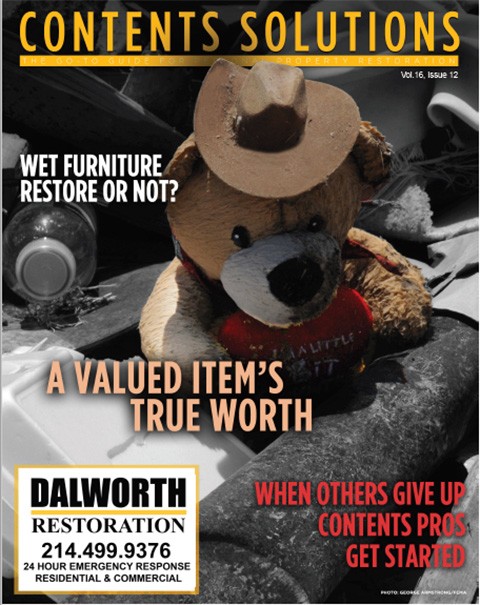24/7 Emergency Services
December 2016:
In past issues of Contents Solutions, we have described some of the specialties that the contents pros perform – everything from restoring valuable art works to decontaminating with baby-safe disinfectants. But we recently ran across a document from the RIA (Restoration Industry Association) that described, in part the bare minimum that would be expected in a flood situation.
We thought our readers might like to know what a top restoration organization recommends for insureds and professionals during typical water damage jobs.
Here are just a few of the things that “Do-It-Yourself Tips for Flood Repair” said:
”Individuals working in an area following a disastrous flood will be exposed to many hazards. The water may contain sewage, pesticides and other waterborne organisms that can cause disease, as well as sharp objects and other debris. Caution should be used upon entering any flood-damaged structure."
1. Remove all contents from areas that were under water and hose down.
2. Double bag and discard all food items and get them off site as quickly as possible.
3. Discard rugs, mattresses, pillows upholstered furniture and other porous materials that have been affected by water.
4. Organic materials such as leather, animal trophies and furs are not restorable.
5. Washable garments, towels and linens can be laundered in hot water and detergent. Items with visible mold are not restorable.
6. Discard refrigerators and other appliances that contain internal insulation.
7. Hard items such as metal, glass, china and finished wood may be decontaminated and restored.
8. Guns and uncoated metals are subject to rust, and should be coated with rust preventive or moisture displacing oil until full restoration can be performed.
9. Wash CDs, DVDs and computer disks with clear water and allow to air dry. Video cassettes and players are not restorable.
10. Computers may be washed with clear water and blow dried. However, regular water may also cause damage to undamaged components. Remove the hard drive and spray with moisture displacing oil, letting it dry completely before reinstalling into the computer and turning it on.
11. Documents and photographs should be stored flat and allowed to dry. Photocopying is the most cost effective way to preserve deeds and other important papers.
12. Damaged antiques and valuable artworks cannot be evaluated immediately. Dry and clean only as necessary to preserve them for a future evaluation by an art restorer or appraiser. Appraisal information is available from the American Society of Appraisers, asainfo@appraisers.org.
13. Continue to list and photograph damaged content. Continue to list and photograph damaged contents during removal. (Consider carrying a small notepad to jot down other items as they come to mind later.)
Of course there is more, but it is a point of personal pride for us that you know true contents pros meet and exceed the recommendations from one of the industry’s top leadership establishments.
WET FURNITURE RESTORE OR NOT?
Restoring tables, chairs, night stands, etc. might be as easy as giving them a thorough cleaning with a deodorizing or disinfecting detergent – depending on the materials used to construct them. Particle board can absorb water like a sponge and will often warp or even disintegrate before any real restoration can be performed.
Plastics, Formica, metal, marble and other stones are more easily restored. Wood furniture – especially if it has been totally or partially submerged, may require a specialist.For wood that is only slightly wet (not submerged), a first priority is that it must be dried, because the moisture can encourage fungus and mold growth.
Contents pros have solutions that can remove white mildew spots. And even for drenched wood, the team can buy time by removing drawers, doors and back panels, then exposing the “skeleton to their normal drying process. But for refinishing, staining, re-gluing of veneers, etc. – depending on the available funds – some companies will do such things in house, and other reach for their million dollar database. Remember, they vet their experts the same way you vet the contents restoration company. So they always get the best associates for specialty jobs.
Water damage cases are never a good time to create a Google search for trained and competent assistance.
CONTENT PROS
The Cutting Edge
Some years ago a recognized expert took umbrage with one of our articles in which we had mentioned that film could be restored.
He explained that wet film was always a total loss. We called various freeze-drying firms and presented his case.
One administrator laughingly responded, “We are taking trays of film out of our machines even as we speak.” Another had restored over 800,000 x-ray films in just one job.
In the RIA article in this issue, the authors stated, “Video cassettes and players are not restorable.” And in years gone by this may have been true, as it related to the average restoration company.
The truth is that many, many contents restoration companies are restoring VHS players, audio cassette players, stereos, televisions and more, even as you read these words.
It isn’t a question of our national advisors being wrong – it is just that we have dedicated researchers who are heavily invested in present and future technology, strategies and techniques.
We hope you will come to value us as cutting edge restoration professionals, because that is what we are! Sometimes we know about state-of-the-art contents restoration methods before the experts even get a chance to publish them. Which saves the carriers massive sums on countless jobs.
Your Million Dollar Database
Earlier in this issue we shared a few basic contents restoration concepts from the RIA (Restoration Industry Association).
And there are a few things we would like to add that may amaze you. The contents pros are not ordinary restoration professionals – they do things that other contractors simply can’t.
That is why contents specialists have raised their collective eyebrows when they read, “Organic materials such as leather, animal trophies and furs are not restorable.”
Ahem! You may recall the article in a past edition of Contents Solutions in which we recounted the story of the contents team that cleaned and restored a leather Coco Chanel purse that had been sprayed by hoses during a fire, covered in mud, frozen and left in a twisted lump on the floor (professionally valued at about $5000 – restored for $79.99).
And in an even earlier edition we told about the “Taxidermist to the Stars,” who routinely restores exotic animal trophies for us (she has restored everything from polar bears to tigers, from aardvarks to zebras – for presidents, movie stars, and even a major Hollywood studio).
So the RIA researchers were right – average restoration professionals probably can’t restore leather and animal trophies. But the contents pros do that and a lot more – art, leather, furniture, antiques, crystal, silver – the list may well be endless.
We use what we call our “Million Dollar Database” (we call it that because in it we have specialists who can save the insurance carriers and the insureds millions each year). It contains a list of top experts who can help us restore massive amounts of valued items that might otherwise be “cashed out.”
When you put us in your “Million Dollar Database,” you have an invisible army behind you that routinely performs restorations that other contractors don’t even attempt.
True Worth
As we mentioned before, wet furniture can pose a myriad of challenges for the contents pros. To determine whether an individual piece is worth restoring, we have to look at the extent of the damage and its intrinsic and sentimental worth. An old table and chair set may have little resale value, but if it was hand sawed by a beloved grandfather during the Great Depression and passed down through the generations, the insured will have great impact on the decision making process – heirlooms can be worth more to the insured than brand new items.
And we have to take into account the cost of replacement (if it can be replaced) in relation to the cost of restoration.
The contents project manager is one of the most valuable components in the decision making process – her (his) expertise can save the carriers massive sums (and massive headaches) just by making the right call.












